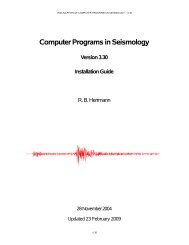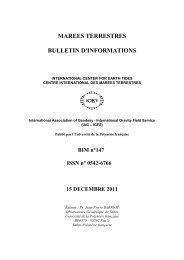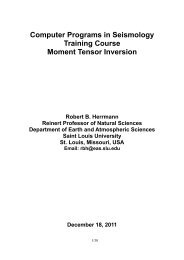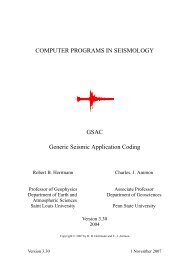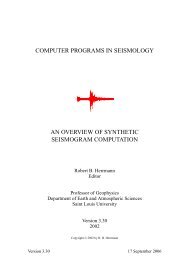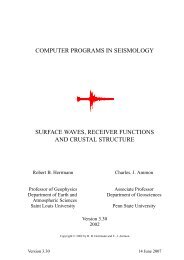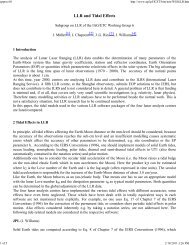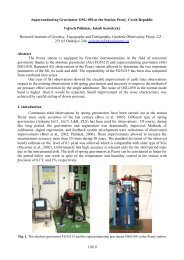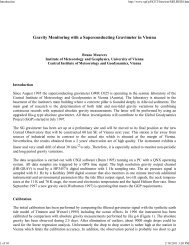3.04 Gravimetric Methods – Superconducting Gravity Meters
3.04 Gravimetric Methods – Superconducting Gravity Meters
3.04 Gravimetric Methods – Superconducting Gravity Meters
Create successful ePaper yourself
Turn your PDF publications into a flip-book with our unique Google optimized e-Paper software.
66 <strong>Superconducting</strong> <strong>Gravity</strong> <strong>Meters</strong><br />
<strong>3.04</strong>.2.3.2 Frequency-dependent admittance 89<br />
<strong>3.04</strong>.2.3.3 Green’s functions and nonlocal pressure corrections 90<br />
<strong>3.04</strong>.2.3.4 3-D atmospheric corrections 91<br />
<strong>3.04</strong>.2.4 Calibration Issues 92<br />
<strong>3.04</strong>.2.4.1 Basics 92<br />
<strong>3.04</strong>.2.4.2 Amplitude calibration, relative methods 93<br />
<strong>3.04</strong>.2.4.3 Amplitude calibration, absolute methods 94<br />
<strong>3.04</strong>.2.4.4 Phase calibration 95<br />
<strong>3.04</strong>.2.5 Other Corrections to Residual <strong>Gravity</strong> 96<br />
<strong>3.04</strong>.2.5.1 Polar motion 96<br />
<strong>3.04</strong>.2.5.2 Instrument drift 96<br />
<strong>3.04</strong>.2.5.3 Hydrology 96<br />
<strong>3.04</strong>.2.5.4 Residual gravity 97<br />
<strong>3.04</strong>.3 Scientific Achievements Using SGs 97<br />
<strong>3.04</strong>.3.1 The Global Geodynamics Project 97<br />
<strong>3.04</strong>.3.2 Seismic and Subseismic Signals 100<br />
<strong>3.04</strong>.3.3 Atmospheric Loading 103<br />
<strong>3.04</strong>.3.4 Tides and Nearly Diurnal Earth Wobbles 104<br />
<strong>3.04</strong>.3.4.1 Resonance effects in diurnal tides 104<br />
<strong>3.04</strong>.3.4.2 Ocean loading 105<br />
<strong>3.04</strong>.3.5 Nontidal Ocean Circulation 106<br />
<strong>3.04</strong>.3.6 Hydrology 107<br />
<strong>3.04</strong>.3.7 Earth Rotation 108<br />
<strong>3.04</strong>.3.8 Tectonic Effects 109<br />
<strong>3.04</strong>.3.9 Ground/Satellite <strong>Gravity</strong> Field Comparison 110<br />
<strong>3.04</strong>.3.10 Future Possibilities 112<br />
<strong>3.04</strong>.4 Conclusions 113<br />
References 115<br />
<strong>3.04</strong>.1 The <strong>Superconducting</strong><br />
Gravimeter<br />
<strong>3.04</strong>.1.1 Historical<br />
<strong>3.04</strong>.1.1.1 Early years at UCSD<br />
The superconducting gravimeter (SG) was first introduced<br />
by Prothero and Goodkind (1968) as part of<br />
Prothero’s (1967) thesis work on the design and development<br />
of the instrument at University of California at<br />
San Diego (UCSD). The SG broke new ground in<br />
geophysics instrumentation, and was an elegant realization<br />
of the principles of superconductivity. Although<br />
the basic sensor configuration has remained unchanged<br />
for nearly 40 years, continuous improvements in all<br />
other aspects of the original design have successfully<br />
converted the SG from a prototype laboratory instrument<br />
to a reliable research tool. (Note that in this<br />
article, the traditional gravity abbreviations are frequently<br />
used: 1 microgal ¼ 1 mGal ¼ 10 mm s 2 ,<br />
1 nanogal¼ 1nGal¼ 0.01 nm s 2 , and cpd ¼ cycles<br />
per (solar) day.)<br />
In 1970, Richard Warburton became a postdoctoral<br />
student with John Goodkind, and this<br />
collaboration was the foundation for the eventual<br />
line of commercial SGs. Richard Reineman, an<br />
undergraduate laboratory assistant working with<br />
William Prothero in 1969, was integral to the effort<br />
as a development technician with Goodkind and<br />
Warburton. Prothero and Goodkind (1972) published<br />
the first observations taken over a 4 month period and<br />
obtained precise tidal amplitude and phases, new<br />
information on ocean tide loading, and a recording<br />
of seismic normal modes following the 7.1-magnitude<br />
Kamchatka earthquake from 1969. Within a few years,<br />
the UCSD group generated significant papers using<br />
SG data on ocean tide loading (Warburton et al., 1975)<br />
and the effects of barometric pressure on gravity<br />
(Warburton and Goodkind, 1977). This phase of the<br />
SG research culminated with a detailed tidal analysis<br />
of 18 months of data that included the first estimate of<br />
the effect of the nearly diurnal wobble on the resonant<br />
amplification of small diurnal tidal phases (Warburton




